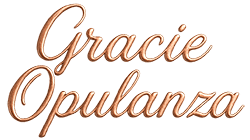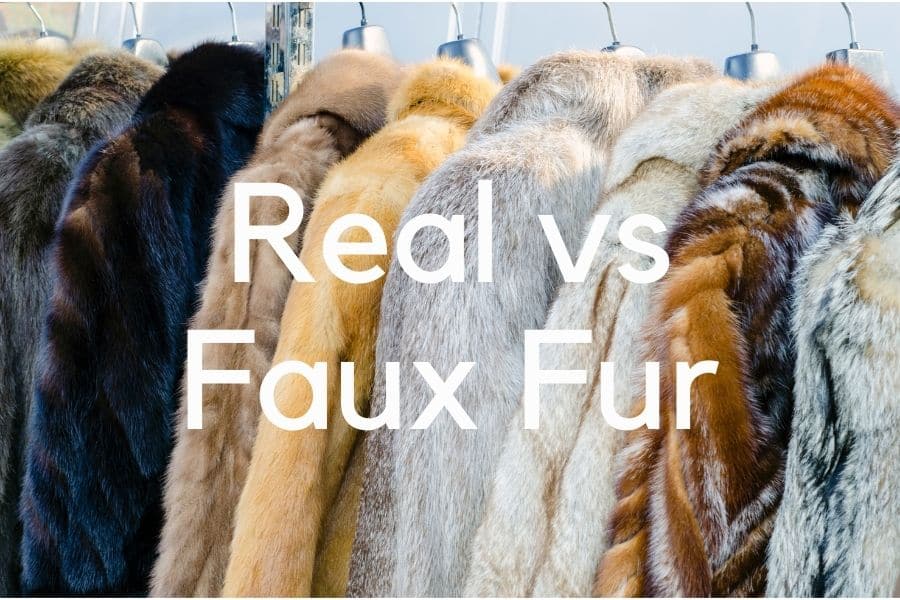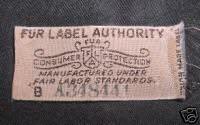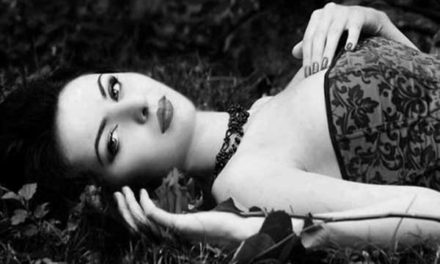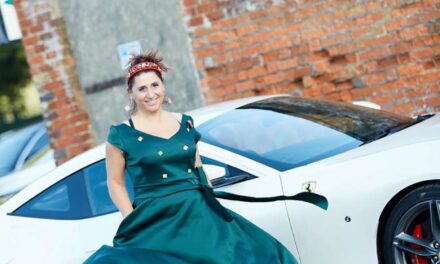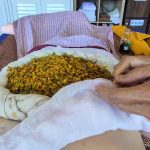For anyone who isn’t an experienced buyer, this should be your first concern when bidding or buying on a fur garment. With advances in synthetic materials, spotting a faux fur can be difficult. Ideally, you should be able to rely on the integrity of the Seller, preferring those who’ll allow a return if an item was misrepresented. But often on marketplaces like eBay and other 2nd hand online retailers, you’ll find sellers who know as little or less about furs than the buyers do. Luckily, even if both parties are total novices, there are easy ways to determine real animal fur from a fake or faux fur. I hope this guide will give you clear and simple instructions on how to check a coat to find out if it is genuine or fake fur.

I am wearing fake fur.
Labels
Though a garment’s label should be proof positive, this isn’t always the case. Some labels always denote faux fur like Mincara, Intrique, Tissavel, Borgana, Glenoit and Grandella. Faux furs are commonly marketed under designer tags and store labels like Talbots, Russell Taylor, Esprit, Belifore, Sears, Gap, Newport News, etc. However, many big names such as Dennis Basso and Anne Klein produce both real and fake furs. All this confusion with brand name tags means that you must research first and not assume that a recognizable label or designer name automatically guarantees authentic fur.
Fur Label Authority Tag
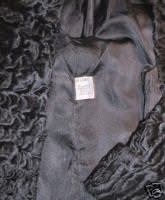
Sometimes, sellers end up with a great looking faux fur and honestly believe it is real fur because it bears a label stating Clean by Furrier Method Only. This label is not commonly applied to genuine fur garments and usually indicates a fake fur. Also, a coat bearing the label from a fur store (like ‘New England Furriers’) is no guarantee either since most furriers sell both real and faux fur coats. So instead of relying on labels, it’s far safer to go by the methods and tests for fur as described below.
Check The Backing
The surest way to determine whether a fur is real or faux is to examine underneath the lining, checking the back of the fur itself. Find a place in the lining where you can either see inside or at least feel the underside of the fur. It’s a fairly simple matter to open up a seam in the lining just an inch or so and only needs to be large enough to poke a finger inside to check the backside. Genuine animal pelts will resemble smooth suede leather and are often sewn together in strips, sections or pieces like a patchwork quilt. Below are example photos of the backing of a muskrat and a fox fur coat.

I am wearing real fur.

Exceptions to this would be furs from larger animals such as Persian lamb, mouton or goat fur. Such fur coats may be sewn in very large sections with few seams, but they’ll still have the unmistakable feel of leather.
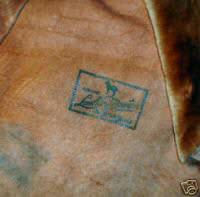
Note – Genuine fur coats will often TWO LININGS, an outer shell of satin-type material and an inner lining of flannel or wool for warmth. So take care to inspect past all linings to be sure you’re examining the fur’s backing.
FAUX or artificial fur can also be readily identified with a visual inspection. You’ll find a uniformed pattern of ribbed fabric or will see little rows like a knitted sweater. And faux fur coats usually do not have a second, inner lining.
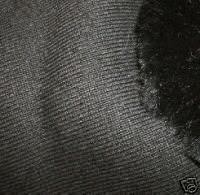
If you’re thinking of bidding on a fur garment where the seller confesses they don’t know whether it’s real or not, you should ask them to check inside the lining for genuine pelts. But what if the seller cannot check the backing of the fur? (It’s uncommon for a seller to refuse to open the lining at least a tiny bit to check inside, so an uncooperative attitude here might tell you something.) Perhaps they can’t find an opening or they don’t want to risk damaging the coat’s lining. If that’s the case, you should insist on the next test.
Burn Test
Clip off fur from a non-visible area or pluck out the hairs from the coat until you have a generous clump of fibres. Hold a match flame to the fibres to examine how they burn and smell. It’s preferable you do this in a closed area like over the bathroom sink so you can determine the odour. Synthetic fibres will alight easily and burn down very rapidly. When burned, faux fur will usually melt into a clump or ball and if there’s any odour at all, smells artificial like plastics. However, genuine fur gives off that distinctive burnt hair odour. Real fur is also more difficult to light, crinkles up very fast just like human hair does and burns into a fine ash. If unsure of the results, try burning a sample of your pet’s hair for comparison.
Judging By The Photos Only
For sellers who have the garment in hand, identifying a real fur from a fake is easy. But eBay buyers are often trying to judge a fur’s authenticity just by looking at a few blurry photos and this is no simple feat. If you can’t see the garment clearly, if the picture is too dark or doesn’t reveal any detail, that task will be an impossible one. Also, the job of trying to evaluate a fur is more difficult if the only photos given are of the coat laying flat. It should be photographed on a model or shown hanging so the buyer can judge how the fur flows or rests naturally. Good quality pictures are a must when a fur’s authenticity is in doubt, so you can’t be shy about requesting better photos.
Few long-haired faux furs (synthetic fox, lynx, raccoon) can measure up in a side-by-side comparison with the real thing. This can also be a reasonably effective way of identifying fakes: simply compare the auction photos of a long-haired fur next to pictures of the one you know is real. Close-up pics of fake fur often reveal clues to their artificial origins: an unnatural glossiness, a scruffy or tangled appearance, the absence of guard hairs, etc. With spotted or striped furs like faux lynx or faux mink, the patterning can be a useful way to distinguish real from artificial. These faux furs are made with a repeating design, so look for unnatural similarities: straight & even lines, identical spot shape or position, few colour variations. Long-haired fakes often look too good; too perfect and matched whereas natural animal pelts won’t appear so balanced, neat or even. Take note, however, that long-haired lamb furs (shearling, Tibetan, Mongolian) can be very difficult to distinguish from fake fur just by photos alone.
When judging by photos alone, look for seams that would indicate the pelt size of that animal. If the garment appears to be continuous with no seams at all, it’s probably fabric, not pelts stitched together. It’s much harder to differentiate real from faux with sheared furs (beaver, mink, muskrat & mouton) and with textured imitation furs like Persian or curly lamb. But remember that faux is fabric- they’re not going to have the same weight or texture as real fur with its leather backing. Below are two pictures of almost identical sheared furs: one fake and one real. Can you tell them apart?
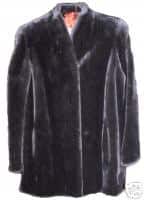
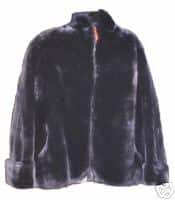
Most fake furs don’t have the same amount of body or firmness of genuine fur, so you may be able to spot telltale ripples or creases. Look closely for folds and wrinkles, especially along the sleeves. The faux one is a very good quality fake; it even has fur hooks & closures. The texture is very similar to the real fur and there are no obvious giveaways. However, look at the sleeve and body panels on the first jacket. See how there are folds and gathers, how it seems to hang more loosely? The real fur has more fullness and doesn’t drape like the first jacket. Based on pictures alone, that floppiness or draping might be the only clue one would have that the first coat is a faux fur.
